|
 Chalciporus aurantiacus Chalciporus aurantiacus
SynonymsXerocomus aurantiacus
Boletus aurantiacus
BiostatusPresent in region - Indigenous. Endemic
Images (click to enlarge)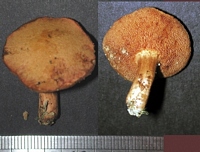
Owner: J.A. Cooper | 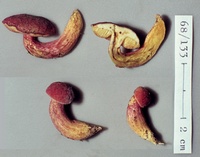
Caption: ZT68-133
Owner: E. Horak: © Creative Commons Attribution-Noncommercial 3.0 New Zealand | 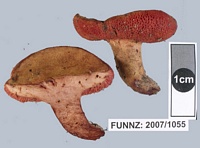
Owner: J.A. Cooper | 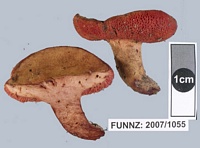
Caption: FUNNZ2007/1055
Owner: FUNNZ | 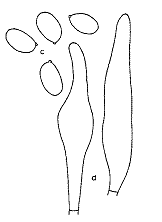
Caption: FIG. 1. Xerocomus aurantiacus: c, spores; d. cystidia. |
Article: McNabb, R.F.R. (1968). The Boletaceae of New Zealand. New Zealand Journal of Botany 6(2): 137-176 (http://www.rsnz.org/publish/abstracts.php).
Description: PILEUS: plano-convex
to applanate, 3-5.5 cm diam., dry, finely felted, golden yellow, apricot or
occasionally reddish orange; cuticle a trichodermium, composed of erect, branched,
septate hyphae 7-10 µm diam., with brownish contents, becoming disorganised
with age; margin entire. HYMENOPHORE: tubes short, to 3mm long, slightly excavated
around apex of stipe, adnate or subdecurrent, dull red; pores concolorous with
tubes, irregularly angular, 0.5-1 mm diam., often radially elongated near apex
of stipe. STIPE: 2-3.5 cm long, more or less equal, 5-8 mm diam., solid, fibrous,
dry, finely granular to furfuraceous by aggregation of caulocystidia, concolorous
with pileus or with general reddish colouration, pallid yellow at extreme apex;
flesh pallid reddish brown; annulus absent.
SPORES: spore print
not obtained; spores melleous, short elliptical to ovate-elliptical, 7.2-9x4.2-5.2
µm. smooth. HYMENIUM: basidia hyaline, clavate, 32-45x8-10 µm, 4-spored; cystidia
sparse, scattered, hyaline, thin-walled, narrowly ventricose-rostrate, 42-60x5.5-10
µm. HYMENOPHORAL TRAMA: bilateral, of the Phylloporus subtype; clamp connections
absent. CONTEXT OF PILEUS: sordid pallid fawn to yellowish fawn, unchanging
on exposure to air. TASTE AND SMELL: not distinctive. CHEMICAL REACTIONS: KOH
on pileus and context of pileus—no definite reaction; NH4OH on pileus—immediate
bright olive green; on context— purplish.
Habitat: HABITAT: Gregarious or caespitose under Nothofagus.
Notes: The short, broad
spores (Q = less than 2) and bright olive green ammonia reaction of fresh pilei
indicate that this species belongs in sect. Pseudogyrodontes as defined
by Singer (1962). Xerocomus aurantiacus is characterised by the golden
yellow, apricot or reddish brown pileus, dull red hymenophore, and short spores.
Article: Pegler, D.N.; Young, T.W.K. (1981). A natural arrangement of the Boletales, with reference to spore morphology. Transactions of the British Mycological Society 76(1): 103-146.
Description: Spores 7-9 x 4.2-6 (7.8 ± 0.7 x 5.2 ± 0.5) µm; Q = 1.50, ovo-ellipsoid with suprahilar
applanation, melleous, surface finely rugulose.
|